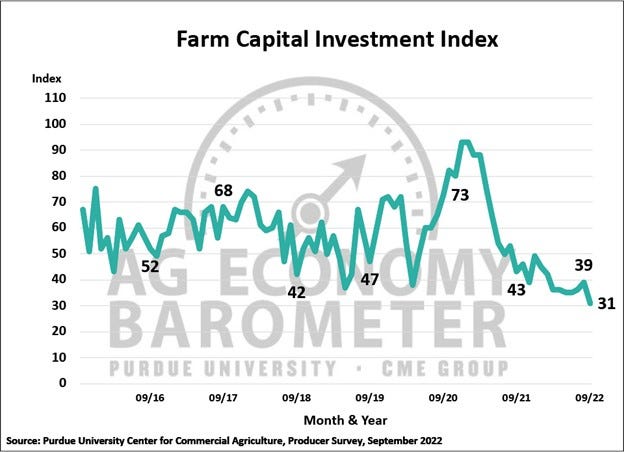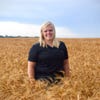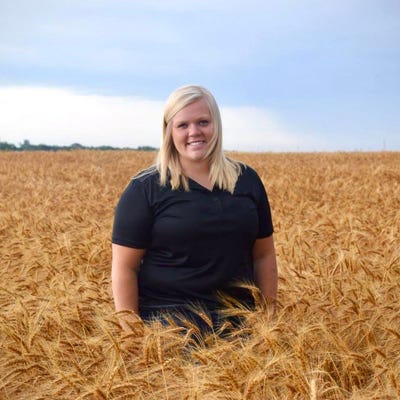
The Purdue University-CME Group Ag Economy Barometer index drifted five points lower to a reading of 112 in September. The decline in farmer sentiment is primarily attributed to producers’ weaker perception of current conditions.
Concerns about input costs and availability are key factors behind the relative weakness in this month's farmer sentiment with a growing number of farmers expressing concern about the impact of rising interest rates on their farms.
Compared to one year ago, the barometer this month is 10% lower, and producers’ assessment of current conditions is down 22%. In contrast, the index of future expectations is only 2% weaker than this time in 2021.

Shifting farmer concerns
Higher input costs are still the number one concern among survey respondents, but U.S. monetary policy is rising to the forefront as a top issue. This month 44% of respondents chose “higher input costs” as their number one concern, down from 53% last month.
Second on the list of concerns for the upcoming year is rising interest rates, chosen by 23% of respondents – a 9% increase since August.
The percentage of farmers with concerns about input availability has been relatively stable over the last 3 months, suggesting this issue is not going away.
Interest rates factor into purchase plans
The Farm Capital Investment Index declined to a record low of 31 in September. Farmers continue to indicate they do not view this as a good time to make large investments for their farming operations.

Despite that negative perspective, fewer farmers plan to reduce their farm machinery purchases this month. Since peaking in March at 62%, the share of producers who plan to reduce their machinery purchases compared to a year earlier has been declining, dipping to 47% this month.
Plans for farm building purchases tell a similar story, declining from a high of 68% who planned to reduce their building and grain bin purchases back in March to 56% who felt that way in the September survey.
When farmers were asked why this is a bad time to make investments, they overwhelmingly cited the increase in prices for farm machinery and new construction. Plus, interest rates are also becoming a factor influencing producers’ decision making.
Throughout the summer, the percentage of farmers who chose “rising interest rates” as a primary reason for thinking it’s a bad time to make large investments rose from 14% in August to 21% in September.
Inputs and inflation
More farmers shared they expect an input price rise for 2023 that matches up more closely with the rate of inflation. Nearly 25% of farmers say they expect input prices to rise from 10% up to 19%.
In April, 18% of respondents expected input prices in 2023 to decline, whereas this month just one out of ten producers said they look for prices to fall up to 10% below 2022’s level.
Cover crop trends
The September farmer survey included questions about cover crop usage. Cover crops are currently planted on a portion of their farmland by 57% of respondants, while around 25% say they have never planted a cover crop. Most producers who report planting cover crops say they only do so on a portion of their farmland.
A large share (40%) of producers who report planting cover crops say they have been planting cover crops for 5 years or less. On the other end of the spectrum, 28% of respondents say they have been planting cover crops for more than 10 years.
Reasons cited by producers for planting cover crops are varied, but improved soil health and erosion control were the top two reasons cited by cover crop users. Only 5% say carbon sequestration is a motivation for planting cover crops.
The Purdue University-CME Group Ag Economy Barometer sentiment index is calculated each month from 400 U.S. agricultural producers’ responses to a telephone survey. This month’s survey was conducted Sept. 19-23, 2022, a week or more following USDA’s September Crop Production and World Agricultural Supply and Demand Estimates.
About the Author(s)
You May Also Like






